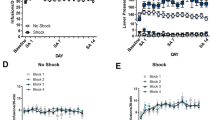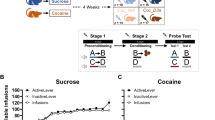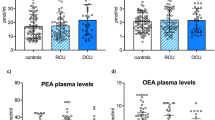Abstract
Cocaine abusers remain vulnerable to drug craving and relapse for many years after abstinence is achieved. We have recently shown that ondansetron (a 5-HT3 receptor antagonist) given 3.5 h after each daily cocaine injection reverses previously established behavioral sensitization. The purpose of the present investigation was two-fold. First, as cocaine cannot be used as therapy, we examined whether pergolide (a D1/D2 receptor agonist with reduced abuse potential) and ondansetron could reverse behavioral sensitization. Second, we investigated whether these behavioral changes were associated with parallel alterations in expression levels and/or phosphorylation changes in the NR2B and GluR1 subunits of the respective NMDA and AMPA receptors. Rats were injected for 5 consecutive days with cocaine or saline followed by 9 days of withdrawal. Starting on withdrawal day 10, animals were given vehicle, pergolide/saline, or pergolide/ondansetron for 5 consecutive days. Following a second 9-day period of withdrawal, all animals were challenged with cocaine for assessment of behavioral sensitization and tissues were collected on the following day for Western blot. Sensitization was associated with increased NR2B expression in the accumbens (NAc) shell and decreased Tyr1472 phosphorylation in the NAc core, as well as increased Ser845 phosphorylation of the GluR1 subunit in prefrontal cortex, NAc core, and shell. Pergolide/ondansetron treatment, but not pergolide alone, consistently reversed both the behavioral sensitization and the associated changes in the NMDA and AMPA receptor subunits. To the extent that sensitization plays a role in chronic cocaine abuse, a combination of these clinically available drugs may be useful in treatment of the disorder.
Similar content being viewed by others
Log in or create a free account to read this content
Gain free access to this article, as well as selected content from this journal and more on nature.com
or
References
Arnt J (1985). Behavioural stimulation is induced by separate dopamine D-1 and D-2 receptor sites in reserpine-pretreated but not in normal rats. Eur J Pharmacol 113: 79–88.
Banke TG, Bowie D, Lee H, Huganir RL, Schousboe A, Traynelis SF (2000). Control of GluR1 AMPA receptor function by cAMP-dependent protein kinase. J Neurosci 20: 89–102.
Blandina P, Goldfarb J, Craddock-Royal B, Green JP (1989). Release of endogenous dopamine by stimulation of 5-hydroxytruptamine 3 receptors in rat stiatum. J Pharmacol Exp Ther 251: 803–809.
Bradford MM (1976). A rapid and sensitive method for the quantitation of microgram quantities of protein utilizing the principle of protein-dye binding. Anal Biochem 72: 248–254.
Chen J, Paredes W, Van Praag HM, Lowinson JH. Gardner EL (1992). Presynaptic dopamine release is enhanced by 5-HT3 receptor activation in medial prefrontal cortex of freely moving rats. Synapse 10: 264–266.
Churchill L, Swanson CJ, Urbina M, Kalivas PW (1999). Repeated cocaine alters glutamate receptor subunit levels in the nucleus accumbens and ventral tegmental area of rats that develop behavioral sensitization. J Neurochem 72: 2397–2403.
Clark BA, Cull-Candy SG (2002). Activity-dependent recruitment of extrasynaptic NMDA receptor activation at an AMPA receptor-only synapse. J Neurosci 22: 4428–4436.
Clemens JA, Okimura T, Smalstig EB (1993). Dopamine agonist activities of pergolide, its metabolites and bormocriptine as measured by prolactin inhibition, compulsive turning and stereotypic behavior. Arzneimittel-Forschung 43: 281–286.
Cornish JW, O'Brien CP (1996). Crack cocaine abuse: an epidemic with many public health consequences. Annu Rev Public Health 17: 259–273.
Davidson C, Lazarus C, Lee TH, Ellinwood EH (2004). Ondansetron, given during the acute cocaine withdrawal, attenuates oral cocaine self-administration. Eur J Pharm 503: 99–102.
Davidson C, Lee TH, Xiong Z, Ellinwood EH (2002). Ondansetron given either in the acute or chronic withdrawal from repeated cocaine sensitization dosing regimens reverses the expression of sensitization and inhibits self-administration. Neuropsychopharmacology 27: 542–553.
De Deurwaerdere P, Stinus L, Spampinato U (1998). Opposite change of in vivo dopamine release in the rat nucleus accumbens and striatum that follows electrical stimulation of dorsal raphe nucleus: role of 5-HT3 receptors. J Neurosci 18: 6528–6538.
Derkach V, Barria A, Soderling TR (1999). Ca2+/calmodulin-kinase II enhances channel conductance of alpha-amino-3-hydroxy-5-methyl-4-isoxazolepropionate type glutamate receptors. Proc Natl Acad Sci USA 96: 3269–3274.
Ellinwood EH, Balster RL (1974). Rating the behavioral effects of amphetamine. Eur J Pharmacol 28: 35–41.
Fitzgerald LW, Ortiz J, Hamedani AG, Nestler EJ (1996). Drugs of abuse and stress increase the expression of gluR1 and NMDAR1 glutamate receptor subunits in the rat ventral tegmental area: common adaptation among cross-sensitizing agents. J Neurosci 16: 274–282.
Gainetdinov RR, Mohn AR, Bohn LM, Caron MG (2001). Glutamatergic modulation of hyperactivity in mice lacking the dopamine transporter. Proc Natl Acad Sci USA 98: 11047–11054.
Gavioli EC, Canteras NS, DeLima TC (1999). Amxiogenic-like effects induced by Substance P injected into the lateral septal nucleus. Neuro Report 10: 3399–3403.
Gawin FH, Ellinwood EH (1988). Cocaine and other stimulants. Actions, abuse, and treatment. N Engl J Med 318: 1173–1182.
Hollmann M, Heinemann S (1994). Cloned glutamate receptors. Annu Rev Neurosci 17: 31–108.
Jakab RL, Goldman-Rakic PS (1998). 5-Hydroxytryptamine2A serotonin receptors in the primate cerebral cortex: possible site of action of hallucinogenic and antipsychotic drugs in pyramidal cell apical dendrites. Proc Natl Acad Sci USA 95: 735–740.
Jakab RL, Goldman-Rakic PS (2000). Segregation of serotonin 5-HT2A and 5-HT3 receptors in inhibitory circuits of the primate cerebral cortex. J Comp Neurol 417: 337–348.
Kalivas PW, Volkow N, Seamans J (2005). Unmanageable motivation in addiction: a path in prefrontal-accumbens glutamate transport. Neuron 45: 647–650.
Kalluri SG, Ticku MK (1999). Potential involvement of tyrosine kinase pathway in the antagonist induced up regulation of the NMDA receptor NR2B subunit in cortical neurons. Mol Brain Res 65: 206–210.
Kampman KM, Alterman AI, Volpicelli VR, Maany I, Muller ES, Luce DD et al (2001). Cocaine withdrawal symptoms and initial urine toxicology results predict treatment attrition in outpatient cocaine dependence treatment. Psychol Addict 15: 52–59.
Karler R, Calder LD, Bedingfield JB (1994). Cocaine behavioral sensitization and the excitatory amino acids. Psychopharmacology 115: 305–310.
Karler R, Calder LD, Chaudhry IA, Turkanis SA (1989). Blockade of ‘reverse tolerance’ to cocaine and amphetamine by MK-801. Life Sci 45: 599–606.
Koob GF, Le Moal M (2001). Drug addiction, dysregulation of reward, and allostasis. Neuropsychopharmacology 24: 97–129.
Lee HK, Barbarosie M, Kameyama K, Bear MF, Huganir RL (2000). Regulation of distinct AMPA receptor phosphorylation sites during bidirectional synaptic plasticity. Nature 405: 955–959.
Levin FR, McDowell D, Evans SM, Brooks D, Spano C, Nunes EV (1999). Pergolide mesylate for cocaine abuse: a controlled preliminary trial. Am J Addict 8: 120–127.
Li Y, White FJ, Wolf ME (2000). Pharmacological reversal of behavioral and cellular indices of cocaine sensitization in the rat. Psychopharmacology 151: 175–183.
Li Y, Wolf ME, White FJ (1997). Co-administration of the NMDA receptor antagonist MK-801 with the dopamine D2 receptor agonist quinpirole reverses behavioral sensitization to cocaine. Soc Neurosci Abstr 23: 261–271.
Loftis JM, Janowsky A (2002). Cocaine treatment- and withdrawal-induced alterations in the expression and serine phosphorylation of the NR1 NMDA receptor subunit. Psychopharmacology 164: 349–359.
Loftis JM, Janowsky A (2003). The N-methyl-D-aspartate receptor subunit NR2B: localization, functional properties, regulation, and clinical implications. Pharmacol Ther 97: 55–85.
Lyon M, Randrup A (1972). The dose–response effect of amphetamine upon avoidance behaviour in the rat seen as a function of increasing stereotypy. Psychopharmacologia 23: 334–347.
Malcolm R, Hutto BR, Phillips JD, Ballenger JC (1991). Pergolide mesylate treatment of cocaine withdrawal. J Clin Psychiatry 52: 39–40.
Malcolm R, Kajdasz DK, Herron J, Anton RF, Brady KT (2000). A double-blind, placebo-controlled outpatient trial of pergolide for cocaine dependence. Drug Alcohol Depend 60: 161–168.
Malcolm R, Moore JW, Kajdasz DK, Ballenger JC (1994). A comparison of pergolide and bromocriptine in the initial rehabilitation of cocaine dependence. Am J Addict 3: 144–147.
Moon IS, Apperson ML, Kennedy MB (1994). The major tyrosine-phosphorylated protein in the postsynaptic density fraction is N-methyl-D-aspartate receptor subunit 2B. Proc Natl Acad Sci USA 91: 3954–3958.
Mulvaney FD, Alterman AI, Boardman CR, Kampman K (1999). Cocaine abstinence symptomatology and treatment attrition. J Sub Abuse Treat 16: 129–135.
Nakanishi S (1992). Molecular diversity of glutamate receptors and implications for brain function. Science 258: 597–603.
Nakazawa T, Komai S, Tezuka T, Hisatsune C, Umemori H, Semba K et al (2001). Characterization of Fyn-mediated tyrosine phosphorylation sites on GluR2 (NR2B) subunit of the N-methyl-D-aspartate receptor. J Biol Chem 276: 693–699.
Nestler EJ, Hope BT, Widnell KL (1993). Drug addiction: a model for the molecular basis of neural plasticity. Neuron 11: 995–1006.
Olanow CW, Watts RL, Koller WC (2001). An algorithm (decision tree) for the management of Parkinson's disease (2001): treatment guidelines. Neurology 56(Suppl 5): S1–S88.
Omkumar RV, Kiely MJ, Rosenstein AJ, Min KT, Kennedy MB (1996). Identification of a phosphorylation site for calcium/calmodulin dependent protein kinase II in the NR2B subunit of the N-methyl-D-aspartate receptor. J Biol Chem 271: 31670–31678.
Paxinos G, Watson C (1986). The Rat Brain in Stereotaxic Coordinates. Academic Press: San Diego, CA.
Pierce RC, Kalivas PW (1997). A circuitry model of the expression of behavioral sensitization to amphetamine-like psychostimulants. Brain Res Rev 25: 192–216.
Rammes G, Rupprecht R, Ferrari U, Zieglgansberger W, Parsins CG (2001). The N-methyl-D-asparate receptor channel blockers memantine, MRZ2/579 and other amino-alkyl-cyclohexanes antagonize 5-HT3 receptor currents in cultured HEK-293 and N1E-115 cell systems in a non-competitive manner. Neurosci Ltr 306: 81–84.
Robinson TE, Berridge KC (1993). The neural basis of drug craving: an incentive-sensitization theory of addiction. Brain Res Rev 18: 247–291.
Roche KW, O'Brien RJ, Mammen AL, Bernhardt J, Huganir RL (1996). Characterization of multiple phosphorylation sites on the AMPA receptor GluR1 subunit. Neuron 16: 1179–1188.
Scheggi S, Mangiavacchi S, Masi F, Gambarana C, Tagliamonte A, Montis MGDE (2002). Dizocilpine infusion has a different effect in the development of morphine and cocaine sensitization: behavioral and neurochemical aspects. Neuroscience 109: 267–274.
Seeburg PH (1993). The molecular biology of mammalian glutamate receptor channels. Trends Neurosci 16: 359–365.
Smart TG (1997). Regulation of excitatory and inhibitory neurotransmitter-gated ion channels by protein phosphorylation. Curr Opin Neurobiol 7: 358–367.
Smith DA, Browning M, Dunwiddie TV (1993). Cocaine inhibits hippocampal long-term potentiation. Brain Res 608: 259–265.
Snyder GL, Allen PB, Fienberg AA, Valle CG, Huganir RL, Nairn AC et al (2000). Regulation of phosphorylation of the GluR1 AMPA receptor in the neostriatum by dopamine and psychostimulants in vivo. J Neurosci 20: 4480–4488.
Staedt J, Huneriager H, Ruther E, Stoppe G (1998). Pergolide: treatment of choice in restless legs syndrome (RLS) and nocturnal Myoclonus syndrome (NMS). Longterm follow up on pergolide. J Neural Transm 105: 265–268.
Ungless MA, Whistler JL, Malenka RC, Bonci A (2001). Single cocaine exposure in vivo induces long-term potentiation in dopamine neurons. Nature 411: 583–587.
Vincent SL, Khan Y, Benes FM (1995). Cellular colocalization of dopamine D1 and D2 receptors in rat medial prefrontal cortex. Synapse 19: 112–120.
Westphal RS, Tavalin SJ, Lin JW, Alto NM, Fraser IDC, Langeberg LK (1999). Regulation of NMDA receptors by an associated phosphatase-kinase signaling complex. Science 285: 93–96.
Witkin JM, Nichols DE, Terry P, Katz JL (1991). Behavioral effects of selective dopaminergic compounds in rats discriminating cocaine injections. J Pharmacol Exp Ther 257: 706–713.
Wolf ME (1998). The role of excitatory amino acids in behavioral sensitization to psychomotor stimulants. Prog Neurobiol 54: 679–720.
Wolf ME (2002). Addiction: making the connection between behavioral changes and neuronal plasticity in specific pathways. Mol Interv 2: 146–157.
Wolf ME, Mangiavacchi S, Sun X (2003). Mechanisms by which dopamine receptors may influence synaptic plasticity. Ann NY Acad Sci 1003: 241–249.
Yamaguchi M, Suzuki T, Abe S, Hori T, Kurita H, Asada T et al (2002). Repeated cocaine administration differentially affects NMDA receptor subunit (NR1, NR2A-C) mRNAs in rat brain. Synapse 46: 157–169.
Acknowledgements
We are grateful to Dr Qiang Chen and Mrs Xueying Xiong for their excellent technical assistance. We also acknowledge the statistical assistance from Dr Ramona M Rodriguiz in the Department of Psychiatry and Behavioral Sciences at the Duke University Medical Center. This study was supported by grants from the National Institute of Drug Abuse (DA-10327 and DA-14323 to EHE and DA-06519 to THL).
Author information
Authors and Affiliations
Corresponding author
Rights and permissions
About this article
Cite this article
Zhang, X., Lee, T., Davidson, C. et al. Reversal of Cocaine-Induced Behavioral Sensitization and Associated Phosphorylation of the NR2B and GluR1 Subunits of the NMDA and AMPA Receptors. Neuropsychopharmacol 32, 377–387 (2007). https://doi.org/10.1038/sj.npp.1301101
Received:
Revised:
Accepted:
Published:
Issue date:
DOI: https://doi.org/10.1038/sj.npp.1301101
Keywords
This article is cited by
-
Molecular changes in the medial prefrontal cortex and nucleus accumbens are associated with blocking the behavioral sensitization to cocaine
Scientific Reports (2015)
-
Secretory leukocyte protease inhibitor is a proliferation and survival factor for pancreatic cancer cells
Clinical and Translational Oncology (2015)
-
Cocaine-Induced Changes in NMDA Receptor Signaling
Molecular Neurobiology (2014)
-
Ionic Regulation of Cell Volume Changes and Cell Death after Ischemic Stroke
Translational Stroke Research (2014)
-
Restoration of klotho expression induces apoptosis and autophagy in hepatocellular carcinoma cells
Cellular Oncology (2013)



